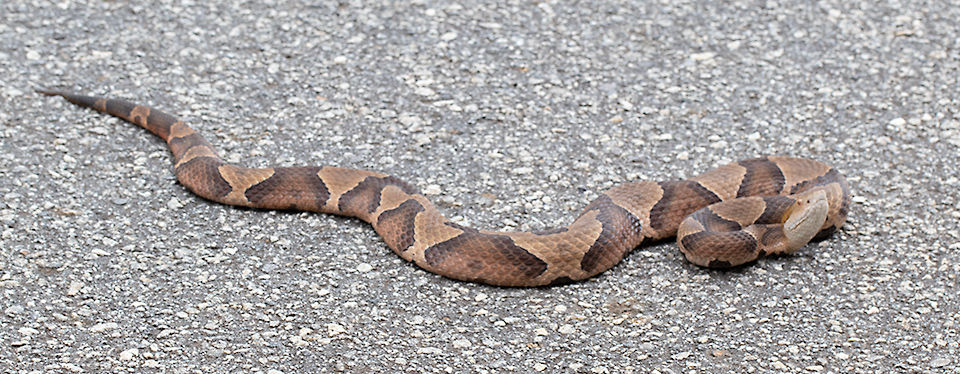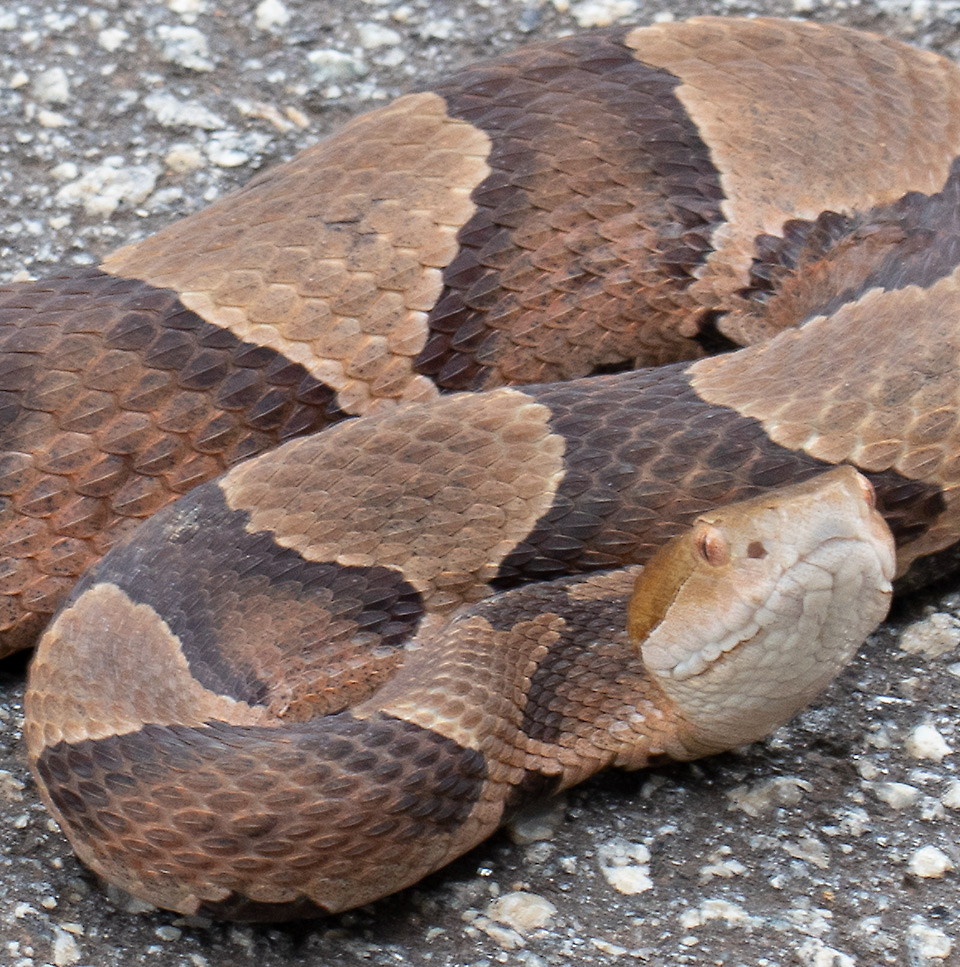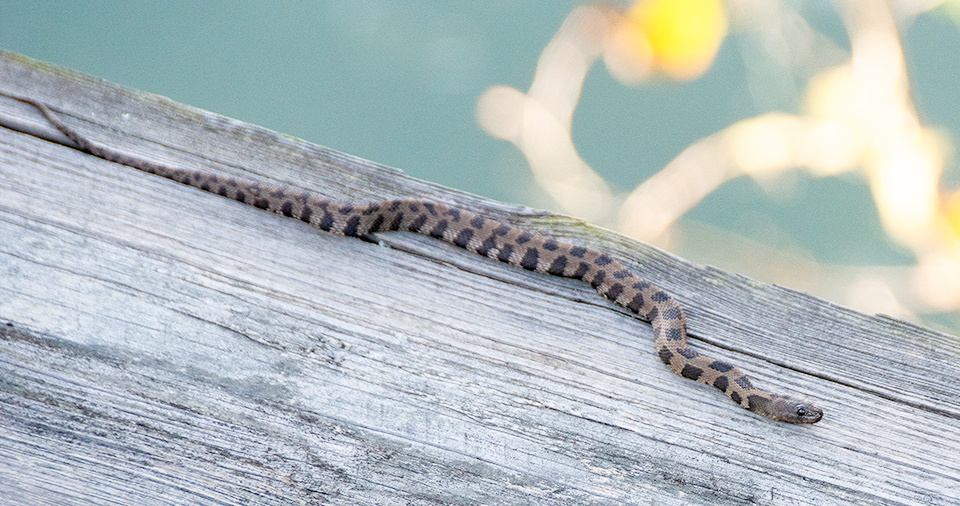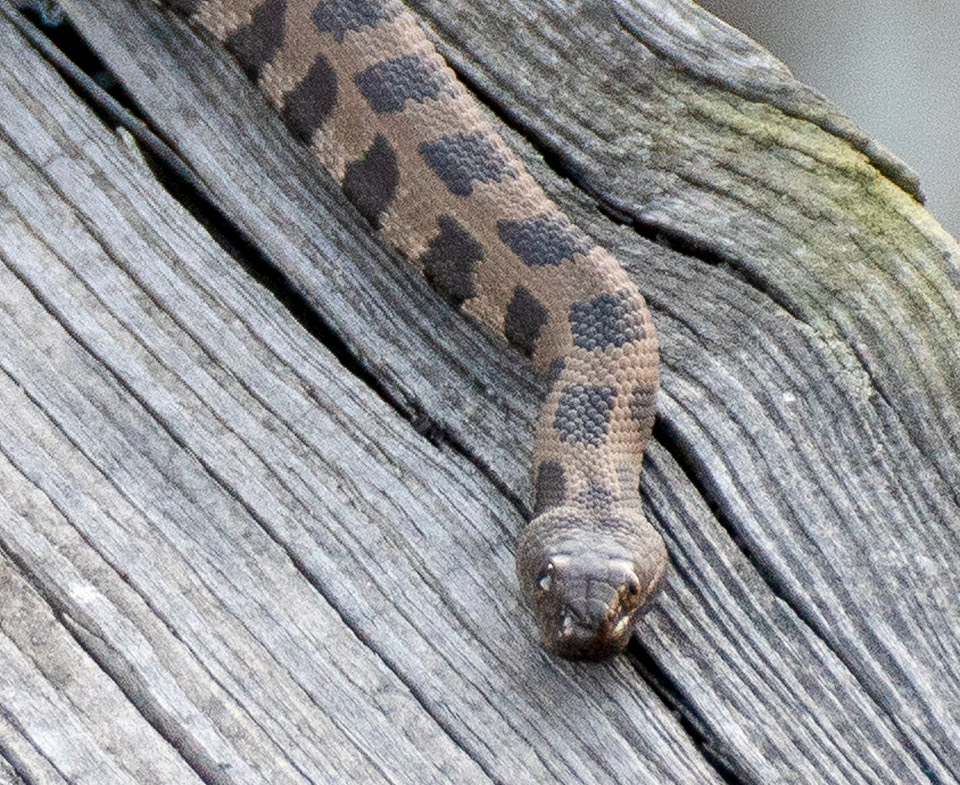Joyce and I were taking our friend Betty, who was visiting from England, out for a ride yesterday. We were traveling on a two-lane highway, and Joyce was driving. As we topped a hill, we came upon a snake on the road. It was spread out nearly full length in our lane of traffic. Joyce was able to straddle the snake, and we turned around as soon as we could find a place so that we could come back and investigate. There was no place to pull the car off the road, so we had to watch for traffic both ways.

It was obvious at a glance that the snake was a magnificent Copperhead (Agkistrodon controtrix) with the chunky build of a pit viper, and the dark colored “inverted Y” markings characteristic of this species. We were not able to measure this one, but I judged it to be near the maximum length commonly seen in our area.

With a closer look, the vertical pupil characteristic of our local pit vipers can be seen. The scales can be seen to have prominent ridges along their center line.
There was not a lot of traffic on the road, but we wanted to prevent oncoming cars from running over the snake, while at the same time I wanted to be able to take the pictures that you see in this post. So I stationed my self near the snake. First a van came speeding over the hill. I waved my arms and pointed at the snake. Fortunately, the van slowed slightly and straddled the snake without hitting it. Next came a sedan with a woman driving and some children in the car. Again, I waved my arms and pointed at the snake. The car stopped in the road a few feet from the snake and observed the proceedings. I was able take a couple of photographs before the snake decided it had seen enough, turned around, and crawled off, apparently completely uninjured, into the tall grass along the side of the road. This relieved the necessity of finding some way to get the snake off the road and out of danger.
Copperheads are quite interesting creatures. They are closely related to another pit viper found locally, the Cottonmouth, also called the Water Moccasin (Agkistrodon picivorus). The Copperhead is sometimes called the Upland Moccasin. Copperheads are venomous, and a bite from one can cause serious complications. However, Copperhead bites are almost never fatal, and their venom is rated one of the least toxic of all the pit vipers. As with the bites from other venomous snakes, bites can vary a great deal. Copperheads can regulate the amount of venom they inject into a bite, and not infrequently will inject little venom or even none at all, a so-called “dry bite”.
Copperheads usually hunt by locating in a promising spot and ambushing any prey that passes nearby. Their usual food items are small rodents such as mice and voles. However, they are also known to be fond of frogs, and surprisingly, at least to me, they also eat large insects. Apparently they are quite fond of emerging cicadas, and will climb trees to eat them. I once met a man on Daufuskie Island who used to catch Copperheads for sale to a company that collected their venom for medical research. He told me that the easiest way to collect Copperheads was to look around the base of trees during the season when cicadas were emerging from the ground and climbing trees to molt into the winged form. Sometimes a dozen or more Copperheads will aggregate around a single tree and eat the cicada larvae as they emerge from the ground and begin to climb the tree to molt. The larvae emerge from just after darkness falls to about midnight. You can read a lengthier description of this phenomenon at this article.

We also took our guest Betty to Augusta to visit the Augusta Canal and the excellent museum on site. Later we went to the head gates where the locks are present and the canal begins. See my earlier post for more information about the head gates and the locks on locks. I was looking around at the locks when I heard someone behind me announce that the snake they were observing was a Water Moccasin (Agkistrodon picivorus). He further announced that Water Moccasins can kill you if they bite you. Naturally, I wanted to see this snake. By the time I got to the area, Joyce had already spotted the snake in question. It was stretched out and sunning itself on one of the timbers that were formerly used to open and close the locks. However, the snake was not a Water Moccasin, but was a Brown Water Snake (Nerodia taxispilota) about 18 uncles long. This species is non-venomous.

Brown Water Snakes have a very distinctive color pattern. The ground color is light brown or tan. Three rows of dark brown or black splotches extend down the snake’s body. Two rows of the blotches are seen in these photographs. I could not get close to the snake or get into a position which would allow me to take a photograph showing all three rows. There is considerable variation in the appearance of this species. Older specimens may be very dark, and the splotches may not be obvious at a distance. I would guess that many Brown Water Snakes are killed by people who mistake them for Water Moccasins.
Discover more from A Naturalist's Journal
Subscribe to get the latest posts to your email.

Thanks, always like to read about snakes.